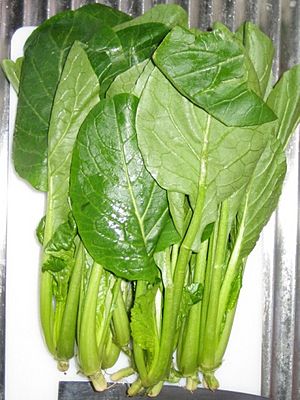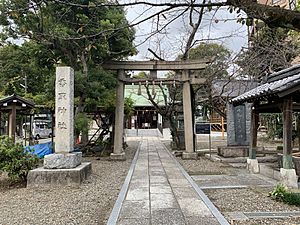Komatsuna facts for kids
Quick facts for kids Komatsuna |
|
|---|---|
 |
|
| Scientific classification | |
| Kingdom: | |
| (unranked): | |
| (unranked): | |
| (unranked): | |
| Order: | |
| Family: | |
| Genus: | |
| Species: | |
| Trinomial name | |
| Brassica rapa var. perviridis |
|
| Nutritional value per 100 g (3.5 oz) | |
|---|---|
| Energy | 92 kJ (22 kcal) |
|
3.9 g
|
|
| Dietary fiber | 2.8 g |
|
0.3 g
|
|
|
Protein
|
2.2 g
|
| Vitamins | Quantity
%DV†
|
| Vitamin A equiv. |
62%
495 μg |
| Thiamine (B1) |
6%
0.068 mg |
| Riboflavin (B2) |
8%
0.093 mg |
| Niacin (B3) |
4%
0.678 mg |
| Pantothenic acid (B5) |
4%
0.178 mg |
| Vitamin B6 |
12%
0.153 mg |
| Folate (B9) |
40%
159 μg |
| Vitamin C |
157%
130 mg |
| Minerals | Quantity
%DV†
|
| Calcium |
21%
210 mg |
| Iron |
12%
1.5 mg |
| Magnesium |
3%
11 mg |
| Manganese |
19%
0.407 mg |
| Phosphorus |
4%
28 mg |
| Potassium |
15%
449 mg |
| Sodium |
1%
21 mg |
| Zinc |
2%
0.17 mg |
|
Link to USDA Database entry
|
|
| †Percentages estimated using US recommendations for adults. | |
Komatsuna (コマツナ(小松菜)) is a popular green leaf vegetable. It is also known as Japanese mustard spinach. Komatsuna is a type of Brassica rapa plant. This plant family also gives us vegetables like turnip, mizuna, and napa cabbage.
Komatsuna is grown a lot in Japan and Taiwan. It's a very useful vegetable because you can cook it in many ways. Sometimes, it's even used as fodder (food for animals) in some Asian countries.
The Story Behind the Name
The name 'komatsuna' means 'greens of Komatsu' in Japanese. This name comes from a village called Komatsugawa in Edogawa, Tokyo. A long time ago, during the Edo period, a lot of komatsuna was grown there.
The vegetable got its name from Tokugawa Yoshimune. He was the eighth shogun (a powerful military ruler) of Japan. In 1719, he visited Edogawa for hunting. He stopped at the local Katori Shrine for lunch. The priest at the shrine served him soup with a rice cake and a local green vegetable.
The shogun really liked the taste of the vegetable. So, he named it komatsuna, after the nearby Komatsu River. Even today, the Shin-Koiwa Katori Shrine offers komatsuna to the gods on New Year's Eve. People who visit the shrine on New Year's Day also get komatsuna. It's given as a symbol of good luck for the new year.
Growing Komatsuna
Over time, komatsuna has been grown to taste sweeter. The older type, which the shogun likely ate, is not common now. That older type is called Goseki bansei. It grows faster and has bigger leaves, but fewer of them. It also has a stronger, spicier flavor.
You can eat komatsuna leaves at any stage of their growth. When the plant is fully grown, its leaves are dark green. They have thin, light green stalks. A mature leaf can be about 30 centimeters (12 inches) long and 18 centimeters (7 inches) wide.
Komatsuna grows best in spring and autumn. It doesn't like very hot or very cold weather for too long. However, these days, it's grown all year round in special greenhouses.
Cooking with Komatsuna
Komatsuna has a fresh, sweet taste and a nice crunchy texture. It's a very flexible vegetable for cooking. You can eat it raw in salads. It can also be pickled, stir-fried, or boiled.
It's a popular addition to soups because it stays firm even after being simmered. Komatsuna is also very healthy for you! It's a great source of calcium, vitamin A, and vitamin C.
See also
 In Spanish: Brassica rapa var. perviridis para niños
In Spanish: Brassica rapa var. perviridis para niños


